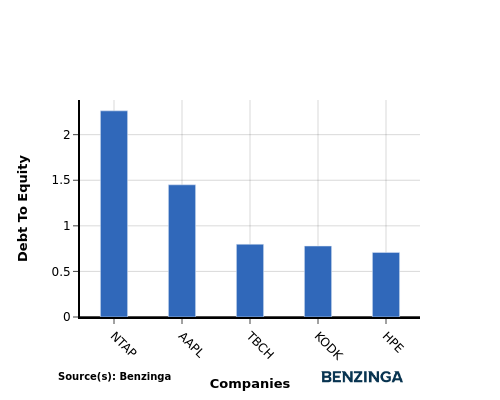Competitor Analysis: Evaluating Apple And Competitors In Technology Hardware, Storage & Peripherals Industry
In the dynamic and fiercely competitive business environment, conducting a thorough analysis of companies is crucial for investors and industry enthusiasts. In this article, we will perform an extensive industry comparison, evaluating
Apple Background
| Company | P/E | P/B | P/S | ROE | EBITDA (in billions) | Gross Profit (in billions) | Revenue Growth |
|---|---|---|---|---|---|---|---|
| 32.15 | 45.57 | 7.83 | 58.74% | 3.95% | |||
| Super Micro Computer Inc | 14.40 | 3.15 | 1.01 | 5.29% | 54.93% | ||
| Hewlett Packard Enterprise Co | 6.87 | 0.74 | 0.62 | 2.39% | 16.27% | ||
| NetApp Inc | 15.42 | 17.27 | 2.70 | 31.69% | 2.18% | ||
| Pure Storage Inc | 133.06 | 10.29 | 4.46 | 3.12% | 11.4% | ||
| Western Digital Corp | 10.35 | 1.03 | 0.79 | 4.89% | 41.33% | ||
| Eastman Kodak Co | 7.06 | 0.80 | 0.56 | 2.46% | -3.27% | ||
| Turtle Beach Corp | 14.37 | 1.86 | 0.63 | 18.11% | 46.76% | ||
| AstroNova Inc | 15.88 | 0.66 | 0.40 | 0.26% | 7.65% | ||
| Average | 27.18 | 4.47 | 1.4 | 8.53% | 22.16% |
By conducting an in-depth analysis of
-
The current Price to Earnings ratio of 32.15 is 1.18x higher than the industry average, indicating the stock is priced at a premium level according to the market sentiment.
-
It could be trading at a premium in relation to its book value, as indicated by its Price to Book ratio of 45.57 which exceeds the industry average by 10.19x.
-
The Price to Sales ratio of 7.83, which is 5.59x the industry average, suggests the stock could potentially be overvalued in relation to its sales performance compared to its peers.
-
The Return on Equity (ROE) of 58.74% is 50.21% above the industry average, highlighting efficient use of equity to generate profits.
-
The company has higher Earnings Before Interest, Taxes, Depreciation, and Amortization (EBITDA) of
$45.91 Billion , which is 117.72x above the industry average, indicating stronger profitability and robust cash flow generation. -
The company has higher gross profit of
$58.27 Billion , which indicates 73.76x above the industry average, indicating stronger profitability and higher earnings from its core operations. -
The company is witnessing a substantial decline in revenue growth, with a rate of 3.95% compared to the industry average of 22.16%, which indicates a challenging sales environment.
Debt To Equity Ratio

The debt-to-equity (D/E) ratio gauges the extent to which a company has financed its operations through debt relative to equity.
Considering the debt-to-equity ratio in industry comparisons allows for a concise evaluation of a company's financial health and risk profile, aiding in informed decision-making.
When assessing
-
Among its top 4 peers,
Apple ( AAPL ) is placed in the middle with a moderate debt-to-equity ratio of 1.45. -
This implies a balanced financial structure, with a reasonable proportion of debt and equity.
Key Takeaways
For
This article was generated by Benzinga's automated content engine and reviewed by an editor.
Related News
-
Nvidia supplier SK Hynix's Q1 profit soars, flags H2 demand risks from tariffs
Reuters - 7:07 PM ET 4/23/2025
-
Nvidia supplier SK Hynix's Q1 profit soars, flags H2 demand risks from tariffs
Reuters - 6:52 PM ET 4/23/2025
-
Nvidia supplier SK Hynix's Q1 profit jumps, beating expectations
Reuters - 6:50 PM ET 4/23/2025
-
US lawmakers subpoena China telecom giants over security concerns
Reuters - 6:20 PM ET 4/23/2025
-
US lawmakers subpoena China telecom giants over security concerns
Reuters - 6:14 PM ET 4/23/2025
-
A Glimpse Into The Expert Outlook On Intel Through 14 Analysts
Benzinga - 6:01 PM ET 4/23/2025
-
Where Ncino Stands With Analysts
Benzinga - 6:01 PM ET 4/23/2025






